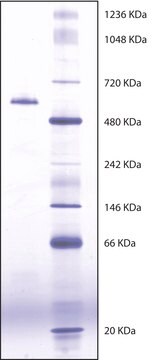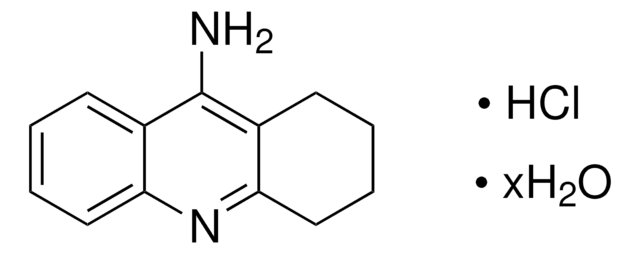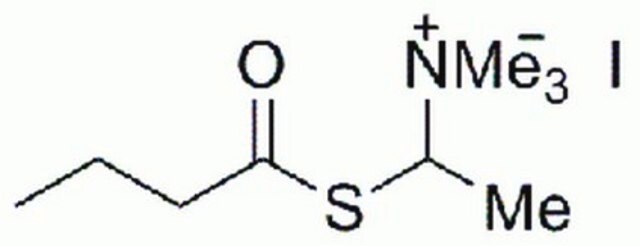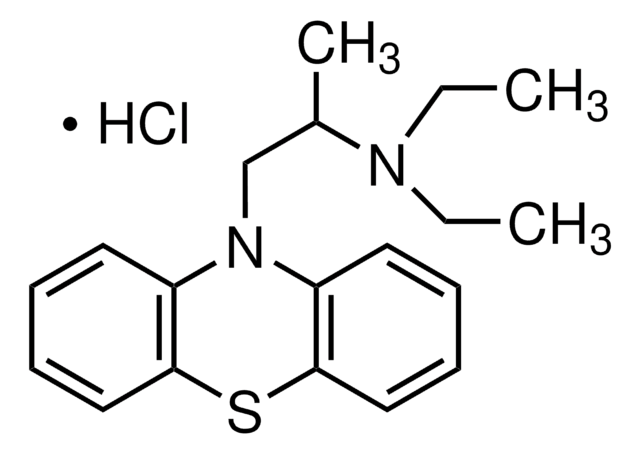C1057
Butyrylcholinesterase from equine serum
lyophilized powder, ≥900 units/mg protein
Synonym(s):
Acylcholine acyl-hydrolase, Choline esterase, butyryl, Pseudocholinesterase
Sign Into View Organizational & Contract Pricing
All Photos(4)
About This Item
Recommended Products
form
lyophilized powder
Quality Level
specific activity
≥900 units/mg protein
mol wt
tetramer 440 kDa
composition
Protein, ≥10%
solubility
H2O: soluble 10 mg/mL
application(s)
diagnostic assay manufacturing
storage temp.
−20°C
Looking for similar products? Visit Product Comparison Guide
Application
Selective inhibition of BChE activity can be used in the detection of organophosphates. Its use in the treatment of organophosphate toxicity has been explored. It has been reported that the level of BChE in human blood correlates to the degree of protection against potentially toxic nerve agents. Cholinesterases have also been investigated for their role in Alzheimer′s disease.
Biochem/physiol Actions
Butyrylcholinesterase (BChE) is a serine hydrolase that is structurally similar to acetylcholinesterase (AChE), but differs in substrate specificities and inhibitor sensitivities.BChE can, unlike AChE, efficiently hydrolyze larger esters of choline such as butyrylcholine and benzoylcholine. The enzyme is a tetrameric glycoprotein with four equal subunits (110 kDa each). The enzyme is activated by Ca2+ and Mg2+. The activity is constant over the pH range of 6.0-8.0. It is inhibited by betaine, nicotine, organophosphates, and carbamate.
Unit Definition
One unit will hydrolyze 1.0 μmole of butyrylcholine to choline and butyrate per min at pH 8.0 at 37 °C. The activity obtained using butyrylcholine as substrate is ~2.5 times that obtained using acetylcholine.
Physical form
Highly purified; contains buffer salts
Analysis Note
Protein determined by biuret
inhibitor
Signal Word
Danger
Hazard Statements
Precautionary Statements
Hazard Classifications
Resp. Sens. 1
Storage Class Code
11 - Combustible Solids
WGK
WGK 3
Flash Point(F)
Not applicable
Flash Point(C)
Not applicable
Personal Protective Equipment
dust mask type N95 (US), Eyeshields, Gloves
Choose from one of the most recent versions:
Already Own This Product?
Find documentation for the products that you have recently purchased in the Document Library.
Customers Also Viewed
Tarek Mohamed et al.
Bioorganic & medicinal chemistry letters, 20(12), 3606-3609 (2010-05-18)
A group of 2,4-disubstituted pyrimidine derivatives (7a-e, 8a-e and 9a-d) that possess a variety of C-2 aliphatic five- and six-membered heterocycloalkyl ring in conjunction with a C-4 arylalkylamino substituent were designed, synthesized and evaluated as cholinesterase (ChE) inhibitors. The steric
Keriman Ozadali-Sari et al.
Bioorganic chemistry, 72, 208-214 (2017-05-10)
The present study describes the synthesis, pharmacological evaluation (BChE/AChE inhibition, Aβ antiaggregation, and neuroprotective effects), and molecular modeling studies of novel 2-[4-(4-substitutedpiperazin-1-yl)phenyl]benzimidazole derivatives. The alkyl-substituted derivatives exhibited selective inhibition on BChE with varying efficiency. Compounds 3b and 3d were found
Jianhua Liu et al.
The Journal of clinical endocrinology and metabolism, 93(5), 1980-1987 (2008-03-20)
Ghrelin, an acylated peptide hormone secreted from the gut, regulates appetite and metabolism. Elucidating its pattern of secretion in the fed and fasted states is important in the face of the obesity epidemic. Our objective was to examine changes in
R M Blong et al.
The Biochemical journal, 327 ( Pt 3), 747-757 (1998-05-15)
Butyrylcholinesterase (BChE) in human serum consists predominantly of tetramers. Recombinant BChE, however, expressed in Chinese hamster ovary (CHO) cells, consists of approx. 55% dimers, 10-30% tetramers and 15-40% monomers. To determine the origin of the monomer species we added the
Determination of butyrylcholinesterase inhibition using ion transfer across the interface between two immiscible liquids
Beattie PD, et al.
Analytical Chemistry, 66(1), 52-57 (1994)
Our team of scientists has experience in all areas of research including Life Science, Material Science, Chemical Synthesis, Chromatography, Analytical and many others.
Contact Technical Service










